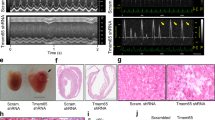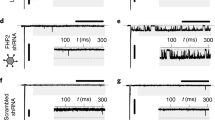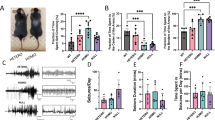Abstract
The channel proteins responsible for the cardiac transient outward K+ current (Ito) of human and rodent heart are composed, in part, of pore-forming Kv4.3 or Kv4.2 principal subunits. Recent reports implicate K+ channel interacting proteins (members of the neuronal Ca2+-binding protein family) as subunits of the Ito channel complex. We reported that another Ca2+-binding protein, frequenin [or neuronal calcium center protein-1 (NCS-1)], also functions as a Kv4 auxiliary subunit in the brain. By examining cardiac expression of NCS-1, the aim of this study was to examine the potential physiologic relevance of this protein as an additional regulator of cardiac Ito. Immunoblot analysis demonstrates NCS-1 protein to be expressed in adult mouse ventricle at levels comparable to that found in some brain regions. Cardiac NCS-1 protein expression levels are much higher in fetal and neonatal mouse hearts when compared with the adult. Immunocytochemical analysis of isolated neonatal mouse ventricular myocytes demonstrates co-localization of NCS-1 and Kv4.2 proteins at the sarcolemma. Given its high levels of expression in the heart, NCS-1 should be considered an important potential Kv4 regulatory subunit, particularly in the immature heart.
Similar content being viewed by others
Main
Ito contributes to the repolarization process of the cardiac action potential and hence plays an important role in determining excitability of the heart. At the molecular level, it is generally believed that Kv4.3 or Kv4.2 subunits are components of channels responsible for human and rodent Ito(1). The expression and localization of Kv4 channels can be regulated by various channel-interacting proteins, including Kvβ-subunits (2), the chaperon-like proteins (KChAP) (3), MiRP1 (4) and filamin (5), which is a cytoskeleton-associated protein. More recently, a group of Ca2+-binding proteins (KChIPs) has been described as physiologically important auxiliary subunits for Kv4 channels (6). The expression of KChIP2 mRNA in the heart (6, 7) and the fact that KChIP2 knock-out mice lack Ito(7) suggest that KChIP2 assembles with Kv4 α subunits to produce the cardiac Ito. The neuronal Ca2+ sensor protein-1 (NCS-1; the mammalian homologue of frequenin) belongs to the same family of neuronal Ca2+-binding proteins that contains the KChIPs. We found NCS-1 to have all of the characteristics that identify it as a bona fide regulatory subunit of Kv4 currents (8). In heterologous expression systems, NCS-1 increases the Kv4 current amplitude, slows its inactivation time course, and accelerates recovery from inactivation. It physically associates with and co-localizes with Kv4.2 subunit in mouse brain. NCS-1 was originally described to have neuronal-specific expression. However, if expressed in the heart, then NCS-1 may, together with KChIPs (6, 7), be considered as an additional regulatory subunit of native cardiac Ito. The aim of this study was therefore to examine, using complimentary approaches, whether NCS-1 is expressed in ventricular myocytes of the mouse heart and to determine its expression level during development.
METHODS
All experimental protocols were performed in accordance with institutional animal guidelines.
Antibodies.
The primary antibodies used were monoclonal anti-myc (clone 9E10), polyclonal chicken anti-NCS-1 (Research Diagnostics, Flanders, NJ, U.S.A.), rabbit anti-NCS-1 (obtained from Dr. Bai Lu, National Institutes of Health, Bethesda, MD, U.S.A.) and rabbit anti-Kv4.2 antibodies (Sigma Chemical, St. Louis, MO, U.S.A., or Chemicon International, Temecula, CA, U.S.A.). The secondary antibodies used for immunoblotting were horse radish peroxidase-conjugated anti-mouse, anti-rabbit IgG (Amersham Pharmacia Biotech, Inc., Piscataway, NJ, U.S.A.) or anti-chicken antibodies (Jackson Immunoresearch, Bar Harbor, ME, U.S.A.). Secondary antibodies for immunocytochemistry included Cy2- or Cy3-conjugated anti-chicken or anti-rabbit IgG (Jackson Immunoresearch).
Western blotting.
Myc-tagged NCS-1 was constructed by subcloning the NCS-1 coding region into the pCS2+MT vector, which contains six myc epitope copies (9). Tissue homogenates were obtained from the hearts or brains of CO2-anesthetized 13 d postconception (dpc) fetal, or from 1-wk-old (neonatal) Swiss Webster mice. A panel of tissues was also obtained from pentobarbital-anesthetized adult mice. Western analysis was performed as described previously (8).
Reverse transcription PCR.
Total RNA, obtained from adult and 13 dpc fetal mouse hearts and brain, was used for reverse transcription. PCR was performed to amplify full-length NCS-1 using the forward primer 5′-GCCATGGGGAAATCCAACAGC-3′ and the reverse primer 5′-CTATACCAGCCCGTCGTAGAGG-3′.
Immunofluorescence microscopy.
Ventricular myocytes were enzymatically isolated from 7- to 10-d-old neonatal mice. Myocytes were plated on poly l-lysine coated glass coverslips and immunocytochemistry was performed as described previously (8). Images were acquired on an Olympus AX-70 using a MagnaFire cooled charge-coupled device camera, or a confocal microscope (LSM 510, Carl Zeiss Inc., Thornwood, NY, U.S.A.).
RESULTS
NCS-1 is expressed in mouse heart.
We first characterized the specificity of the chicken anti-NCS-1 antibody by Western blotting (Fig. 1A). Anti-NCS-1 antibody detected a band of the expected molecular size (30 kD) only in lysates of HEK293 cells that have been transfected with myc-tagged NCS-1 cDNA, but not in untransfected or myc-tagged KChIP1 transfected cells (the presence of the proteins is demonstrated using anti-myc antibodies).
NCS-1 expression in mouse tissues. (A) Characterization of the chicken anti-NCS-1 antibody. HEK293 cells were transfected with myc-tagged NCS-1 or myc-tagged KChIP1 cDNA and Western blotting was performed using anti NCS-1 antibodies (left panel) or anti-myc antibodies (right panel). (B) Tissue distribution of NCS-1 protein expression in adult mouse (2 μg of proteins per lane). Immunoblotting was performed using chicken anti-NCS-1 antibodies (1/5000). (C) Expression of NCS-1 protein in mouse heart and brain during development [5 μg protein per lane from 13 dpc fetal (F), 7-d neonatal (N), or adult (A) mouse heart or brain]. Immunoblotting was performed using rabbit anti-NCS-1 antibodies (1/300). Similar results were obtained using chicken anti-NCS-1 antibodies. (D) Expression of NCS-1 mRNA in mouse heart and brain during development. Reverse transcriptase PCR was performed using total RNA from adult (A) or 13 dpc fetal (F) mouse heart or brain.
Proteins prepared from a panel of tissues from adult mice were subjected to immunoblotting (Fig. 1B). In the brain, NCS-1 is expressed at highest levels in the forebrain (which includes the olfactory bulb), with lower levels in the midbrain and the cerebellum. Although NCS-1 expression was originally described to be neuron-specific, recent evidence demonstrates that NCS-1 is also expressed in other cell types (10). Our immunoblot data show that NCS-1 is expressed in the mouse heart at levels corresponding to those found in the midbrain and cerebellum. NCS-1 expression is undetectable in liver, skeletal muscle, spleen, and thymus.
When examining cardiac expression of NCS-1 during development (Fig. 1C), we found NCS-1 to be expressed at high levels in the fetal heart with declining protein levels after birth. This expression pattern was mirrored when measuring NCS-1 mRNA levels (Fig. 1D), suggesting that the developmental regulation of NCS-1 expression is transcriptional in nature. In contrast to the declining expression with age in the heart, we found NCS-1 expression in brain tissue to peak after birth (with lower expression levels at the fetal or adult stages;Fig. 1C).
Subcellular localization of NCS-1 and co-localization with Kv4.2 proteins.
To determine the subcellular localization of NCS-1 in immature ventricular myocytes, we performed immunocytochemistry using myocytes isolated from neonatal mouse hearts. Strong immunostaining was detected at sarcolemmal regions in all myocytes examined (Fig. 2A), with clustering occurring at regular intervals (arrows in inset). NCS-1 immunostaining was not observed in nonpermeabilized myocytes (Fig. 2B).
NCS-1 is expressed at the sarcolemma and co-localizes with Kv4.2 channel protein in isolated neonatal (7- to 10-d-old) mouse ventricular myocytes. Immunocytochemistry was performed. Strong immunostaining was detected at sarcolemmal regions in all myocytes examined (A), with clustering occurring at regular intervals (arrows in inset). NCS-1 immunostaining was not observed in nonpermeabilized myocytes (B) Double staining of a permeabilized myocyte using chicken anti-NCS-1 and rabbit anti-Kv4.2 antibodies (the secondary antibodies used were, respectively, CY3-conjugated anti-chicken and CY2-conjugated anti-rabbit IgG) (C). The scale bar depicts 20 μm.
We performed double-staining experiments to examine the possibility of co-localization of Kv4.2 and NCS-1 proteins in immature myocytes. Although all cells were stained with Kv4.2 antibody, a subpopulation of myocytes (∼30%) exhibited stronger staining [this is most likely due to the known regional heterogeneity of Kv4.2 expression in the rodent heart (11)]. Consistent with a previous report (12), we found strong Kv4.2 immunostaining at the t-tubular system (Fig. 2C). Co-localization of Kv4.2 and NCS-1 at sarcolemmal regions and the t-tubular system is illustrated by the overlay image (yellow punctate staining in Fig. 2C). These data extend our previous finding of co-localization of Kv4.2 and NCS-1 protein in mouse brain and further demonstrate that, at a subcellular level, NCS-1 is localized in heart cells in a manner that interaction with Kv4 proteins is likely to occur.
DISCUSSION
KChIP proteins modulate Kv4 current amplitude and gating kinetics when expressed in heterologous expression systems. KChIPs also co-localize with, and co-immunoprecipitate with Kv4.2 proteins in mouse brain (6). Because KChIP2 mRNA is expressed in the heart (6, 13, 7), and deletion of KChIP2 gene leads to a complete loss of Ito in ventricular myocytes (7), KChIP2 appears to be an essential component of Kv4 channels in the heart. We recently demonstrated that NCS-1/frequenin exhibit many of these properties, making it a candidate as an additional Kv4 regulatory subunit (8). We found NCS-1 to increase Kv4.2 and Kv4.3 current amplitude, inactivation time course, and channel availability without affecting other rapidly inactivating K+ channels (including Kv1.4 and Kv3.4). As is the case for KChIPs, we found overlapping expression patterns of NCS-1 and Kv4.2 in mouse brain and direct interaction occurring between NCS-1 and Kv4.2 proteins isolated from mouse brain.
In our present study, we demonstrate NCS-1 to be expressed strongly in mouse heart. Our observation is supported by the recent finding that NCS-1 co-immunoprecipitates with Kv4.3 proteins in mouse heart (14). We also found NCS-1 to be co-localized with Kv4.2 protein at the sarcolemma of immature cardiac myocytes. This unique subcellular localization of NCS-1 (together with its known interaction with Kv4.2 proteins) and physical association between NCS-1 and Kv4 channels make it an additional candidate as a regulatory subunit of native cardiac Ito channels.
We found the expression of NCS-1 in the mouse heart is highest in the fetus and declines after birth. Previous reports demonstrate that Kv4.2 mRNA and protein levels (as well as Ito density) increase during postnatal development in the rat (15). However, the increase in Ito density between postnatal d 5 and 30 is larger than that expected based on Kv4.2 protein expression patterns (15). It is therefore possible that NCS-1, with an elevated expression level in the fetal and neonatal heart, may play an important role in increasing the density of Ito at this early developmental stage. In contrast, it has been reported that KChIP2 expression is higher in adult heart than in fetal heart (7). Thus, KChIP2 may be the predominant regulator of Kv4 channels in the adult heart, whereas NCS-1 may be more physiologically relevant in the immature heart (or perhaps also during heart failure, when reversal to fetal gene expression patterns often occurs (16). Given its high Ca2+ sensitivity relative to KChIPs (17, 10) and the higher cytosolic Ca2+ levels in immature heart (18), our data suggest that NCS-1 is poised as a potentially important regulatory subunit of cardiac Ito channels, especially so in the immature heart. However, NCS-1 is known to be a multifunctional protein in neurons and other tissues, with roles ranging from regulation of neurotransmission, phosphatidylinositol 4-kinase activity and ion channel activity (10, 19–21). It is therefore possible that NCS-1 may have additional functions in the immature heart that remain to be elucidated.
Abbreviations
- Ito:
-
transient outward K+ current
- KChIPs:
-
K+ channel interacting proteins
- NCS-1:
-
neuronal calcium center protein-1 (also known as frequenin)
References
Coetzee WA, Amarillo Y, Chiu J, Chow A, Lau D, McCormack T, Moreno H, Nadal MS, Ozaita A, Pountney D, Saganich M, Vega-Saenz DM, Rudy B 1999 Molecular diversity of K+ channels. Ann N Y Acad Sci 868: 233–285
Nakahira K, Shi G, Rhodes KJ, Trimmer JS 1996 Selective interaction of voltage-gated K+ channel beta-subunits with alpha-subunits. J Biol Chem 271: 7084–7089
Kuryshev YA, Wible BA, Gudz TI, Ramirez AN, Brown AM 2001 KChAP/Kvbeta1.2 interactions and their effects on cardiac Kv channel expression. Am J Physiol Cell Physiol 281: C290–C299
Zhang M, Jiang M, Tseng GN 2001 minK-Related peptide 1 associates with Kv4.2 and modulates its gating function: potential role as beta subunit of cardiac transient outward channel?. Circ Res 88: 1012–1019
Petrecca K, Miller DM, Shrier A 2000 Localization and enhanced current density of the Kv4.2 potassium channel by interaction with the actin-binding protein filamin. J Neurosci 20: 8736–8744
An WF, Bowlby MR, Betty M, Cao J, Ling HP, Mendoza G, Hinson JW, Mattsson KI, Strassle BW, Trimmer JS, Rhodes KJ 2000 Modulation of A-type potassium channels by a family of calcium sensors. Nature 403: 553–556
Kuo HC, Cheng CF, Clark RB, Lin JJ, Lin JL, Hoshijima M, Nguyen-Tran VT, Gu Y, Ikeda Y, Chu PH, Ross J, Giles WR, Chien KR 2001 A defect in the Kv channel-interacting protein 2 (KChIP2) gene leads to a complete loss of Ito and confers susceptibility to ventricular tachycardia. Cell 107: 801–813
Nakamura TY, Pountney DJ, Ozaita A, Nandi S, Ueda S, Rudy B, Coetzee WA 2001 A role for frequenin, a Ca2+-binding protein, as a regulator of Kv4 K+-currents. Proc Natl Acad Sci U S A 98: 12808–12813
Roth MB, Zahler AM, Stolk JA 1991 A conserved family of nuclear phosphoproteins localized to sites of polymerase II transcription. J Cell Biol 115: 587–596
Burgoyne RD, Weiss JL 2001 The neuronal calcium sensor family of Ca2+-binding proteins. Biochem J 353: 1–12
Dixon JE, McKinnon D 1994 Quantitative analysis of potassium channel mRNA expression in atrial and ventricular muscle of rats. Circ Res 75: 252–260
Takeuchi S, Takagishi Y, Yasui K, Murata Y, Toyama J, Kodama I 2000 Voltage-gated K+ Channel, Kv4.2, localizes predominantly to the transverse-axial tubular system of the rat myocyte. J Mol Cell Cardiol 32: 1361–1369
Rosati B, Pan Z, Lypen S, Wang HS, Cohen I, Dixon JE, McKinnon D 2001 Regulation of KChIP2 potassium channel beta subunit gene expression underlies the gradient of transient outward current in canine and human ventricle. J Physiol 533: 119–125
Guo W, Malin SA, Johns DC, Jeromin A, Nerbonne JM 2002 Modulation of Kv4-encoded K+ currents in the mammalian myocardium by neuronal calcium sensor-1. J Biol Chem 277: 26436–26443
Xu H, Dixon JE, Barry DM, Trimmer JS, Merlie JP, McKinnon D, Nerbonne JM 1996 Developmental analysis reveals mismatches in the expression of K+ channel alpha subunits and voltage-gated K+ channel currents in rat ventricular myocytes. J Gen Physiol 108: 405–419
Colucci WS 1997 Molecular and cellular mechanisms of myocardial failure. Am J Cardiol 80: 15L–25L
Osawa M, Tong KI, Lilliehook C, Wasco W, Buxbaum JD, Cheng HY, Penninger JM, Ikura M, Ames JB 2001 Calcium-regulated DNA binding and oligomerization of the neuronal calcium-sensing protein, calsenilin/DREAM/KChIP3. J Biol Chem 276: 41005–41013
Haddock PS, Coetzee WA, Cho E, Porter L, Katoh H, Bers DM, Jafri MS, Artman M 1999 Subcellular [Ca2+]igradients during excitation-contraction coupling in newborn rabbit ventricular myocytes. Circ Res 85: 415–427
Hendricks KB, Wang BQ, Schnieders EA, Thorner J 1999 Yeast homologue of neuronal frequenin is a regulator of phosphatidylinositol-4-OH kinase. Nat Cell Biol 1: 234–241
Pongs O, Lindemeier J, Zhu XR, Theil T, Engelkamp D, Krah-Jentgens I, Lambrecht HG, Koch KW, Schwemer J, Rivosecchi R 1993 Frequenin—a novel calcium-binding protein that modulates synaptic efficacy in the Drosophila nervous system. Neuron 11: 15–28
Weiss JL, Archer DA, Burgoyne RD 2000 Neuronal Ca2+ sensor-1/frequenin functions in an autocrine pathway regulating Ca2+ channels in bovine adrenal chromaffin cells. J Biol Chem 275: 40082–40087
Author information
Authors and Affiliations
Corresponding author
Additional information
Supported by the National Institutes of Health (Grant 1 R01 HL71058-01 to W.A.C.), the American Heart Association (Scientist Development Award 013019N to T.Y.N.), and by the Seventh District Association, Inc. E.S. was the recipient of a medical student research fellowship from the Society for Pediatric Research.
Rights and permissions
About this article
Cite this article
Nakamura, T., Sturm, E., Pountney, D. et al. Developmental Expression of NCS-1 (Frequenin), a Regulator of Kv4 K+ Channels, in Mouse Heart. Pediatr Res 53, 554–557 (2003). https://doi.org/10.1203/01.PDR.0000057203.72435.C9
Received:
Accepted:
Issue Date:
DOI: https://doi.org/10.1203/01.PDR.0000057203.72435.C9
This article is cited by
-
Interleukin-11: A Multifunctional Cytokine with Intrinsically Disordered Regions
Cell Biochemistry and Biophysics (2016)
-
Multiple Roles for Frequenin/NCS-1 in Synaptic Function and Development
Molecular Neurobiology (2012)
-
Ncs-1
AfCS-Nature Molecule Pages (2005)





